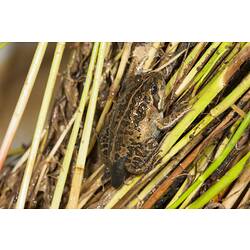General Description
Body brown with multiple dark brown and black stripes. Scattered spots over sides and legs. Some individuals have a narrow, pale yellowish or red stripe down the middle of the back. Wide, dark stripe from the nose, through the eye to the top of the arm. Skin mostly smooth and belly white. Toes unwebbed. Up to 7 cm long. Call a continuously repeated "tock", similar to a clucking hen.
Biology
Striped Marsh Frogs eat a variety of foods including smaller frogs. They breed in still waterbodies including dams, flooded grasslands, roadside ditches and pools from streams. Males call particularly from spring to autumn, and are often well-hidden amongst grass or vegetation when calling. Eggs are laid in floating foam masses attached to vegetation in still waters.
Distribution
Eastern mainland Australia, from north Queensland to southern Victoria, south-eastern South Australia and northern Tasmania.
Habitat
Forests, wetlands, grasslands and woodlands that have still pools of water available.
More Information
-
Animal Type
-
Animal SubType
-
Brief Id
Large brown frog with dark stripes along the back and a dark stripe across the eye.
-
Colours
Brown, Black, White
-
Maximum Size
7 cm
-
Habitats
Wetland, Urban, DryForest, WetForest, Woodland, Mallee, Grassland
-
Diet
Insects
-
Endemicity
-
Commercial
No
-
Conservation Statuses
CITES: Not listed, FFG Threatened List: Not listed, EPBC Act 1999: Not listed, IUCN Red List: Least Concern
-
Taxon Name
-
Scientific Author
(Duméril & Bibron, 1841)
-
Common Name
Striped Marsh Frog
-
Other Names
Brown-striped Frog
-
Kingdom
-
Phylum
-
Subphylum
-
Class
-
Subclass
-
Order
-
Family
-
Genus
-
Species Name
peronii







